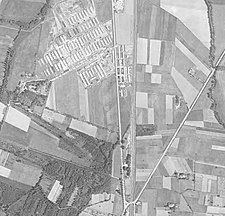Loading AI tools
Concentration camp in Le Vernet, Ariège, France From Wikipedia, the free encyclopedia
Le Vernet Internment Camp, or Camp Vernet, was a concentration camp[1] in Le Vernet, Ariège, near Pamiers, in the French Pyrenees. It was built in 1918 as a barracks, but after World War I it was used as an internment camp for prisoners of war. From February 1939 to June 1944, it was used:
| Camp Vernet | |
|---|---|
| Concentration/Internment/Transit camp | |
 Aerial photograph (1945) | |
| Coordinates | 43°11′43″N 1°36′30″E |
| Location | Le Vernet, Occitania Vichy France |
| Operated by | |
| Original use | Troop camp |
| First built | 1918 |
| Operational | to June 1944 |
| Inmates | Spanish refugees, Jews, former members of the International Brigade |
| Notable books | The Invisible Writing, Scum of the Earth |

Camp Vernet was originally built in June 1918 to house French colonial troops serving in World War I but when hostilities ceased it was used to hold German and Austrian prisoners of war.[4]
Between the wars, it served as a military depot.[4] Towards the end of the Spanish Civil War, in February 1939 in what was called La Retirada (the withdrawal), it was put to a new use until September 1939 as a reception camp for Republicans fleeing from Francisco Franco's armies after the collapse of the Second Spanish Republic. The camp held Republicans the French authorities deemed "a danger to public safety".[4] At this time, it held mainly former soldiers from the Republican Durruti Column,[1][5] the 26th Division and 150 International Brigades members, segregated in an area named "the leper colony". The camp covered an area of about 50 hectares, divided into three sections and surrounded by barbed wire fences.[6]
With the outbreak of World War II, the role of the camp was expanded. It was used to house "undesirable" foreigners, in particular, anti-fascist intellectuals and former members of the International Brigades,[1] particularly the more troublesome or senior veterans.[7]
There is now a small museum at Le Vernet[8] and Le Vernet features in Philip Kerr's 2010 novel Field Grey and in the 2012 novel Citadel by Kate Mosse, which follows the lives of a group of local people and resistance fighters.
After the Fall of France on 25 June 1940, it was taken over by the pro-Nazi Vichy France authorities, to house "all foreigners considered suspect or dangerous to the public order".[1] It then passed to the Germans, who rebuilt it according to their own concentration camp guidelines. Arthur Koestler was a prisoner there and declared that "from the point of view of food, installations and hygiene, Vernet was worse than a Nazi concentration camp".[6] From 1942, Le Vernet was used as a holding centre for Jewish families awaiting deportation to Nazi labour and extermination camps.[1] The final transport, in June 1944, took the remaining prisoners to Dachau concentration camp.[1] One source says that "about 40,000 persons of 58 nationalities were interned in the camp".[1]
Seamless Wikipedia browsing. On steroids.
Every time you click a link to Wikipedia, Wiktionary or Wikiquote in your browser's search results, it will show the modern Wikiwand interface.
Wikiwand extension is a five stars, simple, with minimum permission required to keep your browsing private, safe and transparent.